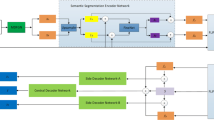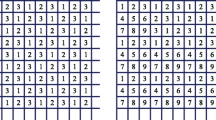Abstract
In this paper, we propose a deep semantic segmentation-based multiple description coding (DSSMDC). In the proposed scheme, the input image is divided into two different subsets and getting two descriptions, which is named multiple description pre-processing (MDP). Then, two descriptions are encoded and decoded respectively by utilizing the deep semantic segmentation codec, in which the semantic segmentation label is as side information for improving image reconstruction quality. We can get one side reconstruction, when only one description is received at the decoder. If both descriptions are received at the decoder, we can get the central reconstruction. Experimental results show that the proposed scheme achieves better performance than other existing compression methods.









Similar content being viewed by others
References
Agustsson E, Mentzer F, Tschannen M, Cavigelli L, Timofte R, Benini L, Gool LV (2017) Soft-to-hard vector quantization for end-to-end learning compressible representations. In: Advances in Neural Information Processing Systems, pp 1141–1151
Agustsson E, Tschannen M, Mentzer F, timofte R, Gool LV (2019) Generative adversarial networks for extreme learned image compression. arXiv:1804.02958v3
Baccaglini, Tillo T, Olmo G (2007) A flexible r-d-based multiple description scheme for jpeg 2000. IEEE Signal Process Lett 14(3):197–200
Ballé J, Laparra V, Simoncelli EP (2017) End-to-end optimized image compression. arXiv:1611.01704v3
Feng J, Wen T, Liu S, Jie R, Xun G, Zhao D (2017) An end-to-end compression framework based on convolutional neural networks IEEE Transactions on Circuits & Systems for Video Technology, PP(99) 1–1
Geng Y, Liang R-Z, Li W, Wang J, Liang G, Xu C, Wang J-Y (2016) Learning convolutional neural network to maximize pos@ top performance measure. arXiv:1609.08417
Geng Y, Zhang G, Li W, Gu Y, Liang R-Z, Liang G, Wang J, Wu Y, Patil N, Wang JY (2017) A novel image tag completion method based on convolutional neural transformation. In: International conference on artificial neural networks. Springer, New York, pp 539–546
Goyal VK (2001) Multiple description coding: compression meets the network. Signal Process Magazine IEEE 18(5):74–93
Guoqian S, Upul S, Jie L, Chao T, Chengjie NT, Tran TD (2009) Multiple description coding with prediction compensation. IEEE Trans Image Process 18(5):1037–1047
He K, Zhang X, Ren S, Sun J (2016) Deep residual learning for image recognition. In: Proceedings of the IEEE conference on computer vision and pattern recognition, pp 770–778
Johnston N, Vincent D, Minnen D, Covell M, Singh S, Chinen T, Hwang SJ, Shor J, Toderici G (2018) Improved lossy image compression with priming and spatially adaptive bit rates for recurrent networks. In: Proceedings of the IEEE Conference on Computer Vision and Pattern Recognition, pp 4385–4393
Lili M, Jie L, Upul S, Yao Z, Huihui B, Kaup A (2014) Multiple description coding with randomly and uniformly offset quantizers. IEEE Trans Image Process 23(2):582–595
Lin C, Tillo T, Zhao Y, Jeon B (2011) Multiple description coding for h. 264/avc with redundancy allocation at macro block level. IEEE Trans Circ Syst Video Technol 21(5):589–600
Liu M, Zhu C (2009) Enhancing two-stage multiple description scalar quantization. IEEE Signal Process Lett 16(4):253–256
Luo S, Yang Y, Yin Y, Shen C, Zhao Y, Song M (2018) Deepsic: Deep semantic image compression. In: International Conference on Neural Information Processing. Springer, New York, pp 96–106
Memos VA, Psannis KE (2016) Encryption algorithm for efficient transmission of hevc media. J Real-Time Image Proc 12(2):473–482
Memos VA, Psannis KE, Ishibashi Y, Kim B-G, Gupta BB (2017) An efficient algorithm for media-based surveillance system (eamsus) in iot smart city framework. Future Gener Comput Syst 83(JUN):619–628
Mohammad Akbari M, Liang J, Han J (2018) Dsslic: Deep semantic segmentation-based layered image compression. arXiv:1806.03348
Psannis KE, Stergiou C, Gupta BB (2018) Advanced media-based smart big data on intelligent cloud systems. IEEE Trans Sustain Comput 4(1):77–87
Simonyan K, Zisserman A (2014) Very deep convolutional networks for large-scale image recognition. Computer Science
Stergiou C, Psannis KE, Kim BG, Gupta B (2018) Secure integration of iot and cloud computing. Future Gener Comput Syst 78(PT.3):964–975
Stergiou C, Psannis KE, Plageras AP, Ishibashi Y, Kim B-G (2018) Algorithms for efficient digital media transmission over iot and cloud networking
Tammam T, Marco G, Gabriella O (2007) Multiple description image coding based on lagrangian rate allocation. IEEE Trans Image Process 16 (3):673–683
Theis L, Shi W, Cunningham A, huszár F (2017) Lossy image compression with compressive autoencoders. arXiv:1703.00395
Tillo T, Grangetto M, Olmo G (2007) Multiple description image coding based on lagrangian rate allocation. IEEE Trans Image Process 16(3):673–683
Tillo T, Olmo G (2004) A novel multiple description coding scheme compatible with the jpeg2000 decoder. IEEE Signal Process Lett 11(11):908–911
Toderici G, O’Malley SM, Hwang SJ, Vincent D, Minnen D, Baluja S, Covell M, Sukthankar R (2015) Variable rate image compression with recurrent neural networks. Computer Science
Toderici G, Vincent D, Johnston N, Hwang SJ, Minnen D, Shor J, Covell M (2017) Full resolution image compression with recurrent neural networks. In: Proceedings of the IEEE Conference on Computer Vision and Pattern Recognition, pp 5306–5314
Vaishampayan VA (1993) Design of multiple description scalar quantizers. IEEE Trans Inform Theor 39(3):821–834
Wang T-C, Liu M-Y, Zhu J-Y, Tao A, Kautz J, Catanzaro B (2018) High-resolution image synthesis and semantic manipulation with conditional gans. In: Proceedings of the IEEE Conference on Computer Vision and Pattern Recognition, pp 8798–8807
Xu Y, Zhu C (2013) End-to-end rate-distortion optimized description generation for h. 264 multiple description video coding. IEEE Trans Circ Syst Video Technol 23(9):1523–1536
Zhang G, Liang G, Li W, Fang J, Wang J, Geng Y, Wang J-Y (2017) Learning convolutional ranking-score function by query preference regularization. In: International conference on intelligent data engineering and automated learning. Springer, New York, pp 1–8
Zhang G, Liang G, Su F, Qu F, Wang JY (2018) Cross-domain attribute representation based on convolutional neural network. In: International Conference on Intelligent Computing. Springer, New York, pp 134–142
Zhao L, Bai H, Wang A, Zhao Y (2018) Multiple description convolutional neural networks for image compression. IEEE Trans Circ Syst Video Technol 1–1
Zhao H, Gallo O, Frosio I, Kautz J (2017) Loss functions for image restoration with neural networks. IEEE Trans Comput Imaging 3(1):47–57
Zhao L, Huihui B, Wang A, Zhao Y (2017) Learning a virtual codec based on deep convolutional neural network to compress image. arXiv:1712.05969
Zhao H, Shi J, Qi X, Wang X, Jia J (2016) Pyramid scene parsing network
Zhou B, Hang Z, Puig X, Fidler S, Barriuso A, Torralba A (2017) Scene parsing through ade20k dataset. In: Computer Vision & Pattern Recognition
Zhu C, Liu M (2009) Multiple description video coding based on hierarchical b pictures. IEEE Trans Circ Syst Video Technol 19(4):511–521
Author information
Authors and Affiliations
Corresponding author
Additional information
Publisher’s note
Springer Nature remains neutral with regard to jurisdictional claims in published maps and institutional affiliations.
Rights and permissions
About this article
Cite this article
Li, X., Meng, L., Tan, Y. et al. Deep semantic segmentation-based multiple description coding. Multimed Tools Appl 80, 10323–10337 (2021). https://doi.org/10.1007/s11042-020-09283-w
Received:
Revised:
Accepted:
Published:
Issue Date:
DOI: https://doi.org/10.1007/s11042-020-09283-w




